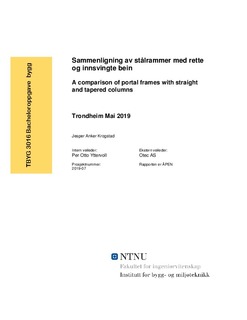| dc.contributor.advisor | Yttervoll, Per Otto | |
| dc.contributor.author | Krogstad, Jesper Anker | |
| dc.date.accessioned | 2019-08-23T14:10:56Z | |
| dc.date.available | 2019-08-23T14:10:56Z | |
| dc.date.issued | 2019 | |
| dc.identifier.uri | http://hdl.handle.net/11250/2610482 | |
| dc.description.abstract | Denne bacheloroppgaven handler om valget mellom rette og innsvingte søyleben i portalrammer av stål. Prosessen har vært veiledet at Per Otto Yttervoll og Otec AS. Omfanget av arbeidet består av å se på økonomien og den effektive bruken av grunnareal ved valg av rette eller innsvingte søyleben, med mål om å finne forutsetninger som gjør én av alternativene å foretrekke fremfor det andre. Innsvingte søyleben gir mindre brukbart areal langs kantene av et bygg, men er ofte bedre utnyttet og billigere. Rette søyleben gir maksimal utnyttelse av grunnareal på bekostning av pris. Målet med oppgaven er å kvantifisere denne prisen.
Arbeidet har forgått med base i Oslo. Korrespondansen med Per Otto Yttervoll har foregått på epost og telefon. Samarbeidet med Otec AS har foregått over Skype, med ett oppstartsmøte på kontoret i Ebeltoft, Danmark for å få en introduksjon i deres arbeidsflyt og tilgjengelige ressurser.
Tre parametere antatt å ha størst innflytelse på konstruksjonen av portalrammer i stål: vegghøyde, snølast og spennvidde. Totalt er åtte situasjoner evaluert fra kombinasjoner av vegghøyde på 3 m eller 6 m, snølast på 2,5 kN/m^2 eller 5,5 kN/m^2 og spennvidde på 12 m eller 24 m. Faste parametere for alle situasjoner har vært takvinkel, vindlast, avstand mellom rammene og krav om IPE-profiler i drager og HEA-profiler i søyleben. For hver situasjon er to rammer dimensjonert ved hjelp av programvaren Halber; én med rette søyleben og én med innsvingte. Disse to rammene er så sammenlignet med hensyn på vekt og hvor mye brukbart grunnareal de gir, og kostnaden for det ikke utnyttbare arealet er kalkulert.
Resultater viser at større snølast og lengre spennvidder gjør det brukbare areal dyrere, mens høyere vegghøyde gjør arealet billigere. Resultatene er imidlertid noe sprikende og har stor varians, men tendensene er klare. Prisen på det ekstra utnyttbare arealet varier fra 337 kr/m^2 til 2853 kr/m^2. Siden rette søyleben må velges fra handelssortimentet av HEA-profiler er det lite rom for spesialtilpasning. Dette sammenfaller med en gjennomsnittlig utnyttelse for rette søyleben på 90 %, mens innsvingte søyleben har en gjennomsnittlig utnyttelse på 98 %. | |
| dc.description.abstract | This bachelor's thesis concerns the choice between straight and tapered columns in steel portal frames for industrial buildings. The work has been carried out with the guidance of supervisor Per Otto Yttervoll and the help of Otec AS. The scope of the report is to look at the economy and the efficient use of ground floor area when choosing between straight and tapered columns, with the aim of finding conditions which are prerequisite for the favourable election between the two alternatives. The main aspect with regard to straight and tapered columns is that a tapered column renders less usable ground area but is often better utilized and cheaper. So by choosing a straight column one can gain usable area at the expense of price. The goal of this report is to quantify this price.
The work has mainly been conducted from Oslo. Correspondence with Mr Yttervoll was conducted over email and telephone, whenever this was needed. The collaboration with Otec AS was managed over Skype, with the exception of one trip to their office in Ebeltoft, Denmark to get an introduction to their workflow and available resources.
Three parameters are assumed to be the most influential for constructing the steel frames; wall height, snow load and span length. A total of eight cases have been evaluated from the combinations of wall height of either 3 or 6 meters, snow load of either 2,5 kN/m^2 or 5,5 kN/m^2 and span length of either 12 or 24 meters. Several parameters are fixed for all cases, such as ceiling slope, wind load, the distance between frames, IPE-profiles in the beam and HEA-profiles in the columns. For each case, two frames have been constructed with the help of the software Halber: one with straight columns and one with tapered columns. These two frames are then compared by weight and by how much ground area remains usable, and the cost of the usable area is calculated for the two options.
The results are not unambiguous due to outliers and variance, but some conclusions can be made. The snow load and the span length both makes the usable area more expensive, but larger wall height has the opposite effect. The price of the extra usable area when choosing straight columns vary from 337 kr/m^2 to 2853 kr/m^2$kr/m^2$. Since straight columns must be chosen from the available selection of hot rolled steel profiles, they have little room for customization. This is supported by the notion that the straight columns have an average utilization of 90 %, whereas the tapered columns on average are utilized to 98 %. | |
| dc.language | nob | |
| dc.publisher | NTNU | |
| dc.title | Sammenligning av stålrammer med rette og innsvingte bein | |
| dc.type | Bachelor thesis | |
